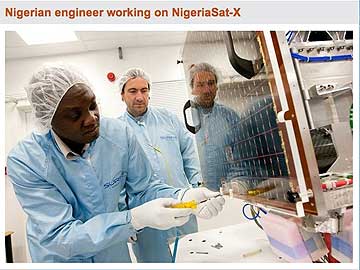
Credit: SSTL NigeriaSat-X was launched into the Disaster Monitoring Constellation in 2011
Small satellite creator Surrey Satellite Technology Ltd (SSTL) plans to jump-start space innovation by combining state-of-the-art avionics with flight proven systems in a low cost 50kg class satellite platform, and for a price tag of around £2m.
Adopting a new set of satellite design paradigms, the SSTL-50 microsatellite has a novel dual-mode design with the sole purpose of supporting and stimulating payload and subsystem innovation. One side of the spacecraft will fly the latest avionics, subsystems and high speed electronics available— either customer supplied or from SSTL — while the other side contains SSTL’s flight proven systems, offering low risk, managed redundancy.
Doug Liddle, Head of Science commented, “We call it technology leapfrogging — we are offering our customers a platform with the very latest technologies combined with the peace of mind of our heritage systems. It’s also a very flexible design making it suitable for a wide range of applications including imaging, communications or even space science. ”
Despite its small size, the SSTL-50 is a sophisticated satellite with sufficient payload accommodation to carry commercial payloads such as the SSTL 22m SLIM-6 imager or low power RF payloads. This platform is also designed for flexible payload integration, providing a vehicle to trial innovative payloads in space — with a rapid delivery of just 12 months from kick-off.
For many institutions, launch and insurance costs can constrain space programs and prevent payloads from being demonstrated in space. In addition to the cost savings offered by its low mass, two SSTL-50 satellites can be launched in a face-to-face “brace” position, making the most efficient use of available space in the launch vehicle. Supporting capacity building and training the next generation of space engineers is another important role for the SSTL-50, where it provides the facility to develop a low cost but fully capable mission in parallel to a training and development program.

